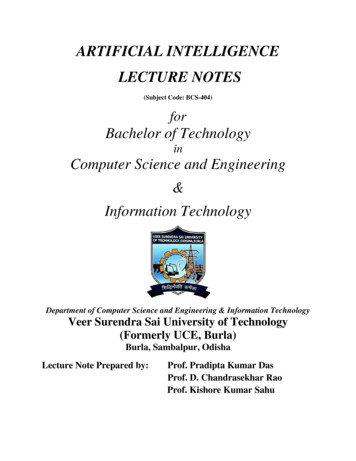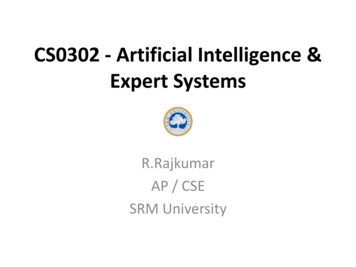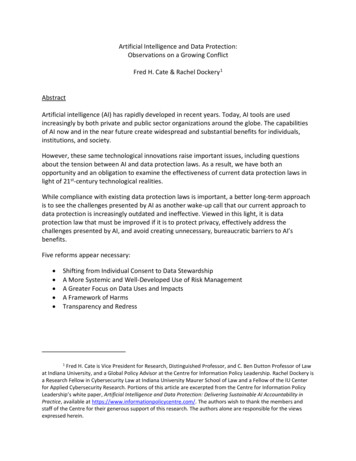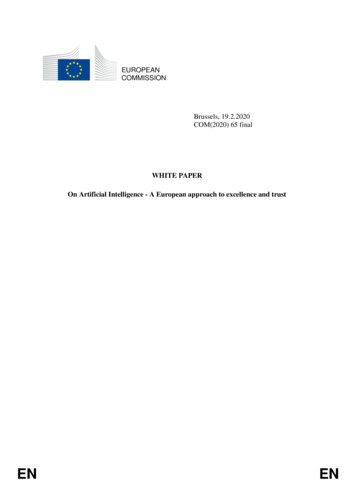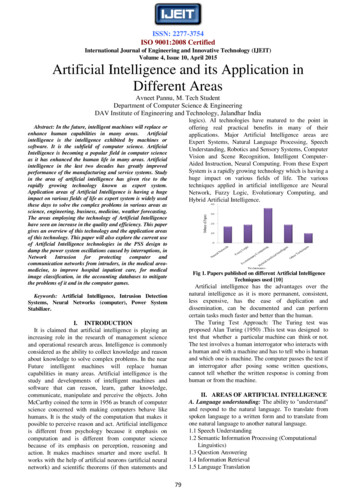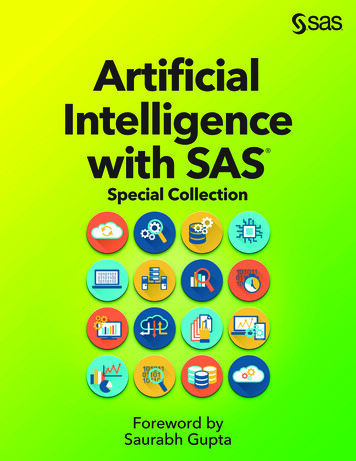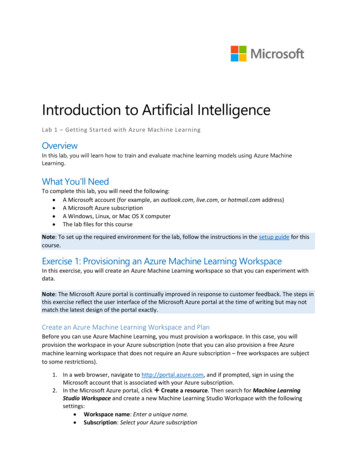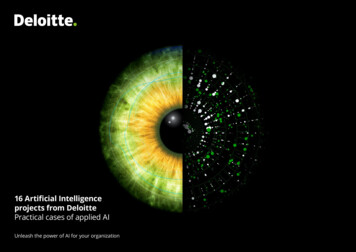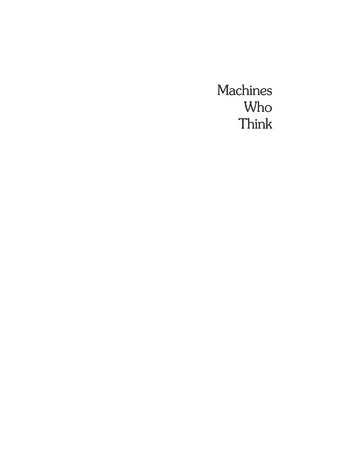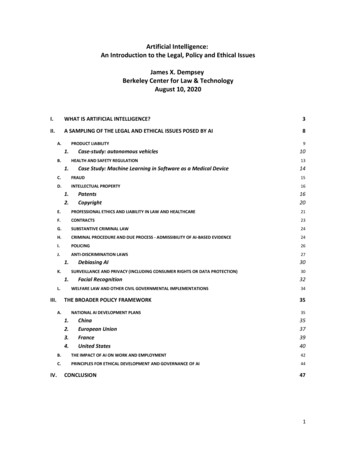
Transcription
Artificial Intelligence:An Introduction to the Legal, Policy and Ethical IssuesJames X. DempseyBerkeley Center for Law & TechnologyAugust 10, 2020I.WHAT IS ARTIFICIAL INTELLIGENCE?3II.A SAMPLING OF THE LEGAL AND ETHICAL ISSUES POSED BY AI8A.PRODUCT LIABILITY1.B.HEALTH AND SAFETY REGULATION1.Case Study: Machine Learning in Software as a Medical Device9101314C.FRAUD15D.INTELLECTUAL PROPERTY161.2.PatentsCopyright1620E.PROFESSIONAL ETHICS AND LIABILITY IN LAW AND HEALTHCARE21F.CONTRACTS23G.SUBSTANTIVE CRIMINAL LAW24H.CRIMINAL PROCEDURE AND DUE PROCESS - ADMISSIBILITY OF AI-BASED EVIDENCE24I.POLICING26J.ANTI-DISCRIMINATION LAWS271.K.L.III.Debiasing AISURVEILLANCE AND PRIVACY (INCLUDING CONSUMER RIGHTS OR DATA PROTECTION)1.Facial RecognitionWELFARE LAW AND OTHER CIVIL GOVERNMENTAL IMPLEMENTATIONSTHE BROADER POLICY FRAMEWORKA.NATIONAL AI DEVELOPMENT PLANS1.2.3.4.IV.Case-study: autonomous vehiclesChinaEuropean UnionFranceUnited States30303234353535373940B.THE IMPACT OF AI ON WORK AND EMPLOYMENT42C.PRINCIPLES FOR ETHICAL DEVELOPMENT AND GOVERNANCE OF AI44CONCLUSION471
“[I]ncreasingly useful applications of AI, with potentially profound positiveimpacts on our society and economy, are likely to emerge between nowand 2030.” AI 100 Study.1“The development of full artificial intelligence could spell the end of thehuman race.” Stephen HawkingThe age of artificial intelligence is dawning. Already AI is widespread, appearing inmultiple contexts, from medical diagnosis to driving directions to stock trading to socialnetworking to policing. As science fiction writer William Gibson said, the future is alreadyhere, it’s just not evenly distributed. It seems likely that every sector of economic activityand every aspect of social and political life will be (is already being) affected by AI. It alsoseems likely, however, that the full impact of AI is impossible to predict. Undoubtedly,there is hyperbole in today’s predictions about AI, both positive and dystopian. In thinkingabout AI, we should keep in mind the observation of another visionary, Roy Amara,founder of the Institute for the Future, who said that we tend to overestimate the shortterm impact of a new technology, but underestimate its long term impact.While the exact shape of the AI-influenced future is uncertain, there is widespreadassumption that the impacts of AI will be profound. As the European Commission said in2018, “The way we approach AI will define the world we live in.”2 Or, as Russia’s Presidentsaid in 2017, the country that masters AI will “get to rule the world.”3Among its many profound implications, AI poses challenges for law, corporate andgovernment policy, and ethics. Courts are being asked to apply traditional legal doctrinesto complex and purportedly unexplainable systems. Policymakers are deciding whether tomodify existing regulatory structures to specifically address AI. Overarching thesegranular choices is the public policy challenge of promoting and shaping the developmentof AI in ways that will be beneficial while mitigating its negative impacts. More law, or AIspecific law, may not be the answer. The report of the AI 100 Study panel convenedunder the auspices of Stanford University concluded: “Rather than ‘more’ or ‘stricter’1PETER STONE ET AL., ARTIFICIAL INTELLIGENCE AND LIFE IN 2030, ONE HUNDRED YEAR STUDY ON ARTIFICIAL INTELLIGENCE 4(2016), 00report10032016fnl singles.pdf [hereinafter AI100 STUDY].Communication from the Commission to the European Parliament, The European Council, The Council, TheEuropean Economic and Social Committee and the Committee of the Regions, COM (2018) 137 final (Apr. 4,2018), 8/EN/COM-2018-237-F1-EN-MAIN-PART1.PDF.2David Meyer, Vladimir Putin Says Whoever Leads in Artificial Intelligence Will Rule the World, FORTUNE(Sept. 4, 2017), igence-putin-rule-world/; Russia Insight,Whoever Leads in AI Will Rule the World (Sept. 4, 2017),https://www.youtube.com/watch?v 2kggRND8c7Q.32
regulation, policies should be designed to encourage helpful innovation, generate andtransfer expertise, and foster broad corporate and civic responsibility for addressingcritical societal issues raised by these technologies.” 4 To decide just what policies areneeded, officials in all branches and at all levels of government will need access totechnical expertise in AI—to translators who can explain the technology behind AI.5Although AI presents substantial legal issues, it is important to recognize that manytraditional doctrines and statutes of general application could answer the issues posed byAI or at least provide the starting point for responding to those issues. As Judge FrankEasterbrook advised, rather than creating technology-specific rules, it is usually better tofirst develop a sound rule, then apply it to computer innovations.6This paper seeks to introduce some of the types of legal, policy, and, to a lesser degree,ethical issues that AI poses. The paper focuses largely on developments and debates inthe United States, with occasional reference to the law or policy frameworks of othercountries. It should be viewed solely as an introduction. There are undoubtedly otherissues not addressed, and for each of the issues that is mentioned there is already a richliterature that it is impossible to even summarize here.I.What is Artificial Intelligence?Although it represents one of the major technologies of our time, there is no common oraccepted definition of artificial intelligence (“AI”). An October 2016 report issued by theObama Administration said, “Some define AI loosely as a computerized system thatexhibits behavior that is commonly thought of as requiring intelligence. Others define AIas a system capable of rationally solving complex problems or taking appropriate actionsto achieve its goals in whatever real world circumstances it encounters.” A 2018 bookissued by Microsoft defines AI as “a set of technologies that enable computers toperceive, learn, reason and assist in decision-making to solve problems in ways that aresimilar to what people do.”7 (But in key ways AI is not similar to human thinking.) TheEuropean Commission’s Communication on AI states, “Artificial intelligence (AI) refers tosystems that display intelligent behaviour by analysing their environment and takingactions–with some degree of autonomy–to achieve specific goals.”AI 100 STUDY, supra note 1, at 43 (“Effective governance requires more experts who understand and cananalyze the interactions between AI technologies, programmatic objectives, and overall societal values.”)45Id.Frank H. Easterbrook, Cyberspace and the Law of the Horse, 1996 U. CHI. LEGAL F. 207, 208(1996) (“Develop a sound law of intellectual property, then apply it to computer networks.”).6Microsoft, THE FUTURE COMPUTED: ARTIFICIAL INTELLIGENCE AND ITS ROLE IN SOCIETY 28 The-Future-Computed 2.8.18.pdf.73
AI can be divided into two basic categories: narrow (or weak) and general (or strong).Narrow AI competes with human thinking and reasoning in one domain.8 An example ofnarrow AI is IBM’s Deep Blue chess-playing program.9 It could beat the best chess playerin the world, but it can’t play checkers. Even very robust AI may be narrow: the AI in aself-driving car could not fly an airplane or even steer a bicycle. (However, techniqueslearned in developing the AI for the self-driving car may make it easier to develop AI for abroad range of other functions.)Narrow AI is already pervasive: AI makes trades on Wall Street,10 determines credit scores, reads and ratesresumes,11 and interprets x-rays.12 It is being integrated into policing and the criminal justice system.13 AI is prominent in self-driving cars, robotic surgical equipment, andmedical diagnostic systems. Your phone uses AI to give prompts for words when you are composing atext. The navigational software on the same phone uses AI to determine thefastest route home. Many of the “May I help you?” boxes that pop up online are chat bots,automated systems that interpret users’ questions and return answers as ifbeing provided by a human customer service representative.See Ben Dickson, What is Narrow, General, and Super Artificial Intelligence, TECHTALKS (May 12, rrow-general-and-super-artificial-intelligence/; Peter Voss,From Narrow to General AI, MEDIUM (Oct. 3, 2017), general-ai-e21b568155b9.89See Ryan Calo, Artificial Intelligence Policy: A Primer and Roadmap, 51 U. CAL. DAVIS 399, 405 n.22 (2017).Michelle Fleury, How Artificial Intelligence is Transforming the Financial Industry, BBC (Sept. 16, 2015),www.bbc.com/news/business-34264380. ("About three quarters of trades on the New York Stock Exchangeand Nasdaq are [now] done by algorithms . . . .")10Riia O’Donnell, AI in recruitment isn't a prediction — it's already here, HR DIVE (Jan. 18, g Freiherr, Why AI By Any Name Is Sweet For Radiology, IMAGING TECHNOLOGY NEWS (Jan. 10, -name-sweet-radiology.12Elizabeth E. Joh, Artificial Intelligence and Policing: First Questions, 41 SEATTLE UNIV. L. REV. 1139 (2018),https://ssrn.com/abstract 3168779. See also Christopher Rigano, Using Artificial Intelligence to AddressCriminal Justice Needs, National Institute of Justice (Oct. 8, 2018) (discussing NIJ support for AI research infour areas: video and image analysis, DNA analysis, gunshot detection, and crime -justice-needs.aspx.134
AI is behind Google search and determines what you see on Facebook; itallows Amazon to suggest to you what books to buy, Netflix to suggestwhat movies to watch, Spotify to compile playlists.14Al-based language translation is built into Google’s search engine and iswidely available in other services.15Whereas narrow AI automates a single activity typically performed by a human, artificialgeneral intelligence (AGI) can perform tasks in more than one domain. It aims to solveproblems never before encountered and to learn how to perform new tasks.16 It is oftensaid that general AI thinks, reasons, and deduces in a manner similar to humans,17 but,again, that is misleading in some important waysAlthough there is a spectrum of developments between narrow and general AI, mostcommentators agree that no system yet developed can truly be designated artificialgeneral intelligence.18 In fact, it is debated whether artificial general intelligence will everbe attained. However, some see important steps towards AGI in systems such as Google’sDeep Mind.19Many definitions of AI recognize that AI is not one thing but a set of techniques. The nonprofit research organization AI Now emphasizes that artificial intelligence “refers to aBernard Marr, The Amazing Ways Spotify Uses Big Data, AI and Machine Learning To Drive BusinessSuccess, FORBES (Oct. 30, 2017), bd2.14Gideon Lewis-Kraus, The Great AI Awakening, N.Y. TIMES (Dec. 14, the-great-ai-awakening.html (describing AI’s role in theevolution of Google translate); Allison Linn, Microsoft reaches a historic milestone, using AI to match humanperformance in translating news from Chinese to English, THE AI BLOG (Mar. 14, lation-news-test-set-human-parity/. But see David Pring-Mill,Why Hasn’t AI Mastered Language Translation, SINGULARITYHUB (Mar. 4, snt-ai-mastered-language-translation/; Celia Chen, AIpowered translation still needs work after errors mar debut at Boao Forum, SOUTH CHINA MORNING POST (Apr.16, 2018), ors-mar-debut-boao.15See Jonathan Howard, A Big Data Cheat Sheet: From Narrow AI to General AI, MEDIUM (May 23, al-intelligence-4fb7df20fdd8.16See Peter Voss, From Narrow to General AI, MEDIUM (Oct. 3, row-to-general-ai-e21b568155b9.17Ben Dickson, What is Narrow, General, and Super Artificial Intelligence, TECHTALKS (May 12, rrow-general-and-super-artificial-intelligence/ (“Narrow AIis the only form of Artificial Intelligence that humanity has achieved so far.”)1819See id.5
constellation of technologies, including machine learning, perception, reasoning, andnatural language processing.”20 Recent developments in AI combine a number oftechnologies: 20Algorithms. Many AI systems involve algorithms, which can be defined as recipesfor processing data or performing some other task. Much of the concern that wasexpressed several years ago with the fairness and transparency of algorithmicdecision-making now is being cast in terms of AI.Machine learning (ML). A machine learning algorithm can process data and makepredictions without relying solely on pre-programmed rules. For example, an MLsystem can use data about some known (often human-classified) objects or eventsof a particular category (”training data”) to identify correlations that can be usedin order to make assessments about other objects or events of the same kind.21The algorithm can “learn” by tuning the weightings of features it relies on in thedata–essentially testing multiple different weightings—to optimize its predictions,so the quality of its predictions improves over time and with more data.Deep learning is a sub-field of machine learning, where algorithms perform twoimportant tasks that human programmers had previously performed: definingwhat features in a dataset to analyze and deciding how to weight those factors todeliver an accurate prediction.22Neural networks. Deep learning uses neural networks, which are programs that,by their interconnections, roughly approximate the neurons in a brain.23 A neuralnetwork analyzes inputs and makes a prediction; if the prediction is wrong, thedeep learning algorithm adjusts the connections among the neurons untilprediction accuracy improves.Natural language processing. AI system have gotten much better at interpretinghuman language, both written and spoken.AI NOW INSTITUTE, THE AI NOW REPORT: THE SOCIAL AND ECONOMIC IMPLICATIONS OF ARTIFICIAL INTELLIGENCE TECHNOLOGIESIN THE NEAR-TERM (July 7, 2016), https://ainowinstitute.org/AI Now 2016 Report.pdf.David Kelnar, The Fourth Industrial Revolution: A Primer on Artificial Intelligence, MEDIUM (Dec. 2, ence-aiff5e7fffcae1 (“All machine learning is AI, but not all AI is machine learning.”). There are more than 15approaches to machine learning, each of which uses a different algorithmic structure to optimize predictionsbased on the data received. Id. For a more nuanced description of machine learning, see Ben Buchanan andTaylor Miller, Machine Learning for Policymakers, Belfer Center (June rs.pdf.21See David Kelnar, The Fourth Industrial Revolution: A Primer on Artificial Intelligence, MEDIUM (Dec. 2,2016), -ff5e7fffcae1 (“All deep learning is machine learning, but not all machine learning is deep learning.”).2223See id.6
Recent advances in machine learning and deep learning techniques have drawn on twokey resources: (1) huge increases in computational power and (2) the availability ofmassive and ever growing amounts of data.24 Indeed, some of the attention currentlydevoted to AI is a continuation of the attention that four or five years ago was lavished onbig data. (The role of big data in AI research has policy implications discussed below.)AI offers the potential to solve problems that humans cannot solve on their own,especially those involving large amounts of data and large numbers of options. AI couldcorrect for human error and bias. For example, an AI-based automobile may avoid drunkdriving accidents25 and AI-based risk assessment programs can avoid racial bias in creditand criminal sentencing decisions.26However, AI is not magic. All AI programs involve human decisions and trade-offs.Algorithms are not value-free. AI may replicate human error or bias or introduce newtypes of errors or bias.27 Judges, regulators, and policymakers need to understand thesebiases and how they may arise in seemingly objective, data-driven processes. A selfdriving car may struggle with ethical choices that humans easily process, such as choosingbetween hitting a shopping cart and a baby stroller.28 An AI system intended to allocatepolice resources where crime is highest may replicate past bias in patterns of policing.29 AI24See Calo, supra note 9, at 402.See Dorothy Glancy et al., A Look at the Legal Environment for Driverless Vehicles (National AcademiesPress 2016) [hereinafter NAS Driverless Cars Study].2526See AI 100 STUDY, supra note 1, at 43.A large and growing body of research identifies racial and gender bias in various AI-based systems. See,for example, Patrick Grother, Mei Ngan and Kayee Honaoka, Face Recognition Vendor Test (FRVT) Part 3:Demographic Effects, NIST (Dec. 2019) 8280.pdf (study of189 facial recognition algorithms from 99 developers found that most had higher error rates with Black,Native American, and Asian faces); Julia Angwin, Jeff Larson, Surya Mattu and Lauren Kirchner, MachineBias (Pro Publica 2016)[hereinafter Pro Publica Study] (finding that software used to measure recidivismwas twice as likely to mistakenly flag Black defendants as being at a higher risk of committing future crimesand twice as likely to incorrectly flag white defendants as low risk): Marcelo Prates, Pedro Avelar and LuisLamb, Assessing Gender Bias in Machine Translation – A Case Study with Google Translate, NeuralComputing and Applications (March 30363 Assessing gender bias in machine translation acase study with Google Translate; Latanya Sweeney, Discrimination in Online Ad Delivery (January 28,2013) https://ssrn.com/abstract 2208240.27See, e.g., Alex Hern, Self-Driving Cars Don’t Care About Your Moral Dilemmas, THE GUARDIAN (Aug. 22, 2016,10.08 AM), /self-driving-cars-moral-dilemmas.28Rashida Richardson, Jason Schultz, and Kate Crawford, Dirty Data, Bad Predictions: How Civil RightsViolations Impact Police Data, Predictive Policing Systems, and Justice (February 13, 2019), New YorkUniversity Law Review Online https://ssrn.com/abstract 3333423297
trained on data that reflects biases that infected past decisions could incorporate thosebiases into future decision-making, yet give such decisions the appearance of objectivity.30The complexity of AI poses challenges to accountability. Human programmers may not beable to explain how a neural network made its predictions.31 Accountability may bestymied by proprietary claims that developers of AI-based products use to shield theirunderlying algorithms.32 A growing body of literature questions the reliability of AI forcertain applications,33 while another body of research is uncovering the vulnerability of AIsystems to adversarial attack.A new field of AI research addresses the black box problem: explainable AI.34 Companieshave emerged that claim to offer explainable AI.35II.AIA Sampling of the Legal and Ethical Issues Posed byCountries around the world already have laws that address the apportionment of liabilityfor injuries resulting from unreasonable behaviors or defective products, that defineintellectual property rights, that seek to ensure fairness in credit and employmentdecisions, that protect privacy, and so on. By and large, “[t]here are no exceptions tothese laws for AI systems.”36 Nor need there be.However, as they have in the face of other technological changes, courts will encounterchallenges in applying traditional rules to AI, and regulatory agencies and legislaturesmust determine whether special rules are needed.30See AI 100 STUDY, supra note 1, at 43.31See id.32Sonia Katyal, Private Accountability in the Age of Artificial Intelligence, 66 UCLA L. Rev. 54 (2019).See, for example, Matthew Salganik, et al., Measuring the predictability of life outcomes with a scientificmass collaboration, PROCEEDINGS OF THE NATIONAL ACADEMY OF SCIENCES (2020)https://www.pnas.org/content/117/15/8398 (160 teams, some using complex machine-learningmethods and working with thousands of predictor variable on thousands of families, were not able to makeaccurate predictions for basic life outcomes).33Tathagata Chakraborti et al., The Emerging Landscape of Explainable AI Planning and Decision Making(02/26/2020), 34See, for example, Sebastian Moss, Lockheed Martin partners with DarwinAI for Explainable AI, AI BUSINESS(May 26, 2020) https://aibusiness.com/document.asp?doc id 761328&site aibusiness.35MICROSOFT, THE FUTURE COMPUTED: ARTIFICIAL INTELLIGENCE AND ITS ROLE IN SOCIETY (2018),https://news.microsoft.com/cloudforgood/ 8
A.Product LiabilityMost countries have laws establishing civil liability for negligent or unreasonable behaviorthat causes damage and for addressing the harms caused by defective products. For AI, asthey have in other areas, legislators may find it desirable to adopt statutes to clarify ormodify these rules, or they may delegate rulemaking authority to regulatory bodies.Meanwhile, courts will fit AI into the existing legal frameworks.“Robots cannot be sued,”37 but their manufacturers and operators can. Already, there hasbeen extensive litigation against manufacturers by workers injured on the job by robots,over the safety of surgical robots, over autopilot systems in airplanes, and over thesoftware already embedded in automobiles.38 By and large, the courts have appliedtraditional concepts to conceptualize liability and apportion it among machines, theirmakers, and users.Globally, legal rules defining liability for products vary, but there has been a distinctmovement away from reliance on negligence and warranty towards the concept of strictliability for defective products.39 This approach holds product manufacturers liable for“defects” in the design or manufacture of the products they make or for failure to providesufficient warning of the risks of such products.In the US, questions of liability are largely a matter of common law, augmented by statuteand varying somewhat state to state, but the principle of strict liability for defectiveproducts is dominant. In Europe, movement towards a strict liability regime began in1977 with the Council of Europe Convention on Products Liability in regard to PersonalInjury and Death. In 1985, the European Union adopted a Product Liability Directive thatcreated a regime of strict liability for defective products.40 To take one other example, inJapan, under the Product Liability Act of 1994, manufacturers face liability for injuries and37United States v. Athlone Indus., Inc., 746 F.2d 977, 979 (3d Cir. 1984).See Quinn Emanuel Trial Lawyers, Artificial Intelligence Litigation: Can the Law Keep Pace with the Rise ofthe Machines (2018), machines/.38See generally Baker McKenzie, Asia Pacific Product Liability Guide 207 (July lications/2017/03/ap-product-liability-guide; GETTING THEDEAL THROUGH, LIABILITY IN 29 JURISDICTIONS WORLDWIDE (Harvey Kaplan, Gregory Fowler & Simon Castley, eds.,2014), http://www.acc.com/ cs upload/vl/membersonly/Article/1394895 1.pdf.39Council Directive 85/374/EEC, 1995 O.J. (L 210), ri CELEX:31985L0374:en:HTML. The preamble to the Directivespecifically notes the role of technology: “liability without fault on the part of the producer is the solemeans of adequately solving the problem, peculiar to our age of increasing technicality, of a fairapportionment of the risks inherent in modern technological production[.]”409
losses caused by products found to be defective.41 In cases where it is unclear whetherthe accident was caused by the human operator or defects in the equipment, evidentiaryrules have been established for allocating blame.42Strict liability is not absolute liability. The definition of design defect turns on thereasonableness of the choices made by the manufacturer, and the process of showingwhat is reasonable or not often involves competing experts.431.Case-study: autonomous vehiclesConsider the likely litigation that will arise around self-driving cars. A well-establishedbody of law already defines the legal liability of the operators and manufacturers oftraditional automobiles. Lawsuits against the drivers of automobiles typically rely on anegligence theory. Suits against manufacturers more often proceed under the theory ofstrict products liability.Unless legislatures act to adopt special rules for autonomous vehicles, courts will applythese doctrines. Negligence concepts are likely to still apply to the operators ofautonomous vehicles (posing the question, perhaps, of who should be classified as theoperator) and strict products liability doctrine will apply to manufacturers. Courts mayencounter evidentiary problems in cases where it is difficult to tell whether an AI robot orhuman operator caused an accident, but this may be not unlike the issues posed by atraditional auto accident.An in-depth 2016 study44 of autonomous vehicles predicted that, overall, cases involvingauto accidents will decrease as driving becomes safer with the diffusion of AI inautomobiles. Where accidents do occur, the type of claims will evolve over time. Asdriverless vehicles become more common and their users grow more competent, claimsagainst users will be replaced by claims that allege defects in driverless vehicles, shiftingliability “upwards” from drivers to manufacturers. These cases will rely on productsliability law, with design defect and warning defect claims expected to be more commonthan manufacturing defect claims.45Iwata Godo, Product Liability in Japan, LEXOLOGY (May 10, ?g e013ff26-a955-4faa-bba0-5b7be84baf4f.41For example, courts have allowed plaintiffs to use circumstantial evidence to establish “manufacturingdefects . . . where the facts reveal that the (presumed) defect destroys the evidence necessary to prove thatdefect or where the evidence is otherwise unavailable through no fault of the plaintiff.” See In re ToyotaMotor Corp. Unintended Acceleration Mktg., Sales Practices, & Prod. Liab. Litig., 978 F. Supp. 2d 1053, 1097(C.D. Cal. 2013).4243See generally David G. Own, Design Defects, 73 MISSOURI L. REV. 291 (2008).44NAS Driverless Cars Study, supra note 25.10
Salient will be the question of what is a defect in design? The advent of driverless cars willlikely pose questions about how such a car should be designed. For example, shoulddriverless cars be designed to always obey the speed limits? How should they deal withthe “trolley problem?”46 Is it a defect not to equip them with sensors that block theiroperation by a driver who is intoxicated? Many similar questions may be posed.“Complications may arise when product liability claims are directed to failures insoftware, as computer code has not generally been considered a ‘product’ but instead isthought of as a ‘service,’ with cases seeking compensation caused by alleged defectivesoftware more often proceeding as breach of warranty cases rather than product liabilitycases.”47Policymakers may choose to divert from traditional tort law in developing liabilitydoctrines for AI. One approach would be to create an AI certification process, limiting tortliability for those who obtain certification, but imposing strict liability on uncertifiedsystems.48 Another approach would be to adopt a regulatory system based on testingsimilar to that for drugs and medical devices.49 A third approach, suggested in Europe,would be an obligatory insurance scheme.50 In the United States, given the federal systemof government, the present gridlock in Congress, and the significant ability of industry toblock or neuter new regulatory legislation, any comprehensive solution seems unlikely.45NAS Driverless Cars Study, supra note 25.See, e.g., Jay Donde, Self-Driving Cars Will Kill People. Who Decides Who Dies?, WIRED (Sept. 21, s-will-kill-people-who-decides-who-dies/ (“To understand thetrolley problem, first consider this scenario: You are standing on a bridge. Underneath you, a railroad trackdivides into a main route and an alternative. On the main route, 50 people are tied to the rails. A trolleyrushes under the bridge on the main route, hurtling towards the captives. Fortunately, there’s a lever onthe bridge that, when pulled, will divert the trolley onto the alternative route. Unfortunately, thealternative route is not clear of captives, either — but only one person is tied to it, rather than 50. Do youpull the lever?”).46
“[I]ncreasingly useful applications of AI, with potentially profound positive impacts on our society and economy, are likely to emerge between now and 2030.” AI 100 Study. 1 “The development of full artificial intelligence could spell the end of the human race.” Stephen Hawking The ag

